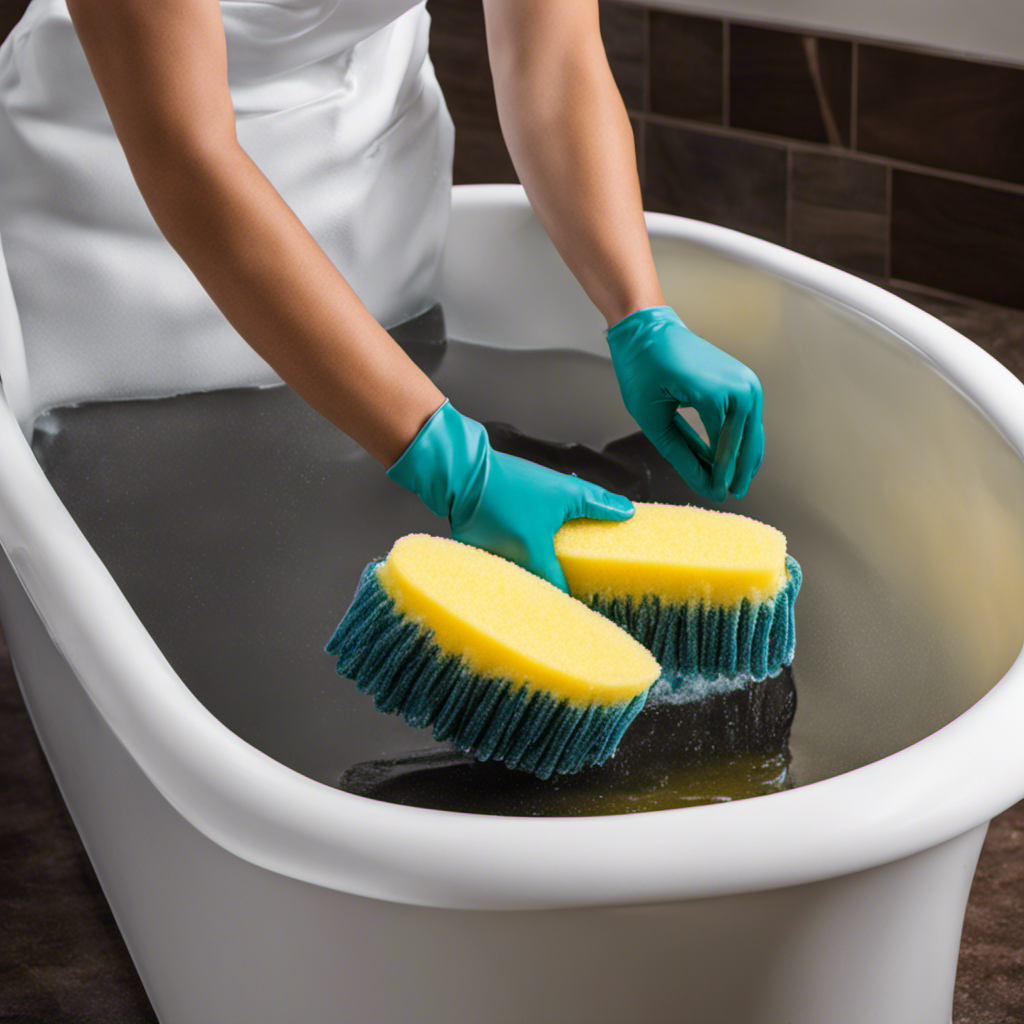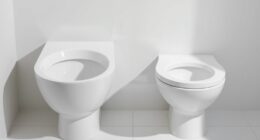I’ve always believed that learning practical skills is like unlocking a new door to independence. And one essential skill we all need is knowing how to wash our clothes, even if we don’t have a washing machine readily available.
That’s where washing clothes in a bathtub comes in handy. In this article, I’ll guide you through the step-by-step process of washing your clothes in a bathtub, so you can keep your wardrobe fresh and clean, no matter the circumstances.
Key Takeaways
- Prepare a basin or bucket to collect used water for other purposes.
- Choose a detergent suitable for handwashing and gentle on fabrics.
- Separate laundry into piles based on color and fabric type.
- Air drying saves energy and reduces carbon footprint.
Gathering the Necessary Supplies
You’ll need to gather the necessary supplies before starting to wash your clothes in the bathtub.
To conserve water, make sure you have a basin or bucket to collect the used water for other purposes, such as watering plants or flushing the toilet.
You’ll also need laundry detergent, preferably one that is eco-friendly to further promote water conservation. Additionally, consider using a washboard or a scrub brush to help remove tough stains.
As for alternative drying methods, have a clothesline or drying rack ready to air dry your clothes. This will not only save energy but also extend the lifespan of your garments.
Now that you have your supplies ready, let’s move on to preparing the bathtub for washing.
Preparing the Bathtub for Washing
When preparing the bathtub for washing clothes, two important factors to consider are the water temperature for soaking and choosing the right detergent.
Firstly, the water temperature for soaking should be warm, around 40-50 degrees Celsius, to help loosen dirt and stains effectively.
Secondly, selecting the right detergent is crucial for achieving clean and fresh-smelling clothes. Look for a detergent that is suitable for handwashing and gentle on fabrics, ensuring it effectively removes dirt and odors.
Water Temperature for Soaking
The water temperature for soaking your clothes in the bathtub depends on the fabric type and level of dirtiness. Choosing the right water temperature is crucial for effective stain removal and preserving the quality of your garments. Here is a guide to help you determine the appropriate water temperature for soaking:
| Fabric Type | Water Temperature |
|---|---|
| Delicate | Cold or lukewarm |
| Cotton | Warm |
| Synthetic | Warm |
| Wool | Cold or lukewarm |
| Stained | Hot |
Soaking clothes before washing offers several benefits. It helps loosen dirt and stains, making them easier to remove during the washing process. Soaking can also help eliminate odors and freshen up your clothes. Additionally, it can help prevent color bleeding and fading. By adjusting the water temperature according to the fabric type and level of dirtiness, you can optimize the stain removal process. Once your clothes are ready, it’s important to choose the right detergent to ensure a thorough and effective clean.
Choosing the Right Detergent
Choosing the right detergent is essential for achieving a thorough and effective clean when washing your garments. Here are three key factors to consider when making your detergent choice:
-
Eco-friendly options: By opting for eco-friendly detergents, you can reduce your impact on the environment. These detergents are formulated with biodegradable ingredients and often come in recyclable packaging. Not only are you doing your part for the planet, but you can also feel good about the products you’re using on your clothes.
-
Fragrance-free options: If you have sensitive skin or allergies, fragrance-free detergents can be a lifesaver. These detergents are free from artificial fragrances and dyes, reducing the risk of skin irritations or allergic reactions. Your clothes will come out clean and fresh without any unnecessary additives.
-
Effectiveness: Look for a detergent that is specifically designed to tackle the type of stains and dirt you commonly encounter. Whether it’s grass stains, grease, or sweat, choose a detergent that has the right enzymes or cleaning agents to effectively remove them.
By considering these factors, you can choose a detergent that not only cleans your clothes effectively but also aligns with your values and needs.
Now, let’s move on to the next step: sorting and pre-treating the laundry.
Sorting and Pre-Treating the Laundry
Start by separating your laundry into different piles based on color and fabric type. This is an important step in ensuring that your clothes are washed properly and don’t get damaged in the process. Sorting techniques can vary, but a common approach is to have three separate piles: whites, darks, and delicates.
Here is an example of how you can sort your laundry:
| Whites | Darks | Delicates |
|---|---|---|
| White t-shirts | Black jeans | Silk blouse |
| White socks | Dark-colored shirts | Lingerie |
| Bed sheets | Sweatpants | Lace underwear |
Once you’ve sorted your laundry, it’s time to pre-treat any stains you may have. Stain removal methods can vary depending on the type of stain and fabric, so it’s important to read the care label and follow the instructions accordingly. Pre-treating stains will help ensure that they are fully removed during the washing process.
Transitioning to the next section, now that your laundry is sorted and any stains have been pre-treated, it’s time to move on to agitating and rinsing the clothes.
Agitating and Rinsing the Clothes
Now it’s time to agitate and rinse your garments in the washing machine to ensure they are thoroughly cleaned. Here are some agitating techniques and water-saving tips that will help you achieve the best results:
-
Use the correct agitation method: Gently move the clothes around in the water by hand or use a plunger or a long-handled spoon to agitate them. Avoid vigorous scrubbing or twisting, as it may damage delicate fabrics.
-
Optimize water usage: Fill the tub with just enough water to cover the clothes. This will save water and energy compared to using a washing machine. Remember, you don’t need excessive amounts of water to get your clothes clean.
-
Rinse with care: After agitating the clothes, drain the soapy water and rinse them thoroughly with clean water. Repeat this step if necessary to ensure all the detergent is removed from the garments.
Drying and Wringing Out Excess Water
When it comes to drying and wringing out clothes, there are several key points to keep in mind.
First, it’s important to explore the best drying methods to ensure that your clothes dry quickly and efficiently.
Additionally, preventing water damage is crucial to maintaining the quality and longevity of your garments.
Finally, learning quick wringing techniques will help you remove excess water from your clothes before hanging them up to dry.
Best Drying Methods
The best way to dry your clothes after washing them in a bathtub is by gently wringing them out and then hanging them up to air dry. Air drying clothes has its own charm and benefits that can make the process worthwhile. Here are three reasons why air drying using a clothesline is a great choice:
-
Energy Efficiency: By using the natural heat and breeze of the outdoors, air drying saves energy and reduces your carbon footprint. It’s an environmentally friendly way to dry your clothes.
-
Freshness: There’s nothing quite like the fresh scent that clothes acquire when dried in the open air. The natural ventilation helps eliminate odors and leaves your clothes smelling clean and revitalized.
-
Gentle Care: Air drying is a gentle method that minimizes wear and tear on your clothes. Unlike a dryer, which can cause shrinkage or damage delicate fabrics, air drying allows your clothes to maintain their shape and longevity.
By choosing to air dry your clothes, you not only save energy and enjoy the freshness, but you also take better care of your garments.
Now let’s move on to the next topic: preventing water damage.
Preventing Water Damage
One effective way to prevent water damage is by regularly checking for leaks and addressing them promptly. By doing so, you can prevent water leakage and minimize water waste.
Start by inspecting all water fixtures such as faucets, toilets, and showers for any signs of leakage. Look for water stains, drips, or pooling water around these areas. If you notice any, it’s important to take immediate action. Repair or replace any faulty or worn-out parts to prevent further damage.
Additionally, regularly check your pipes for leaks by looking for damp spots, water stains, or mold growth on walls, ceilings, or floors. Don’t forget to inspect your water supply lines, especially those connected to appliances like washing machines and dishwashers.
Quick Wringing Techniques
After successfully preventing water damage, it’s time to move on to the next step: quick wringing techniques. When washing clothes in a bathtub, it’s important to remove excess water before drying. Here are three alternative methods for quick wringing:
-
Twist and squeeze: Start by gathering a small section of the garment and twist it tightly. Then, squeeze out the water by applying pressure with your hands.
-
Rolling method: Lay the garment flat on a clean towel and roll it tightly, pressing the towel against the fabric. This helps absorb the water and speed up the drying process.
-
Towel press: Place the wet garment between two dry towels and press down firmly. This method allows the towels to absorb the moisture, leaving the clothes damp instead of soaking wet.
Now that your clothes are partially dried, let’s move on to the next section: properly storing and caring for washed clothes.
Properly Storing and Caring for Washed Clothes
To keep your clothes in good condition, it’s important to properly store and care for them after washing. One key aspect of this is using proper folding techniques.
When folding your clothes, start by smoothing out any wrinkles and ensuring they are completely dry. For shirts, fold them in half lengthwise and then fold the sleeves towards the back, creating a neat rectangle. Pants should be folded in half vertically and then in half horizontally, making sure the legs are aligned.
Additionally, using fabric softener during the wash can help keep your clothes soft and wrinkle-free. Fabric softener helps to reduce friction between fibers, making your clothes feel smoother and more comfortable to wear. It also helps to reduce static electricity and prevents clothes from clinging together.
Frequently Asked Questions
How Long Does It Take to Wash Clothes in a Bathtub?
It usually takes me about 30 minutes to wash clothes in a bathtub. I find that using efficient hand washing techniques, like pre-soaking and agitating, helps to speed up the process.
Can I Wash Delicate Fabrics in a Bathtub?
Yes, you can wash delicate fabrics like silk in a bathtub. However, it is important to handle them gently. If you prefer, you can also hand wash clothes in a sink using a mild detergent.
Can I Use Regular Laundry Detergent in a Bathtub?
I can use regular laundry detergent in a bathtub. However, there are alternative laundry detergents specifically designed for handwashing delicate fabrics. Washing clothes in a bathtub offers benefits like control over water temperature and gentle agitation.
Can I Wash Heavily Soiled Clothes in a Bathtub?
Yes, you can wash heavily soiled clothes in a bathtub. It’s a good alternative to a washing machine. Fill the tub with warm water and detergent, soak the clothes, scrub them, rinse, and hang to dry.
How Often Should I Clean the Bathtub After Washing Clothes in It?
I clean the bathtub after washing clothes to maintain cleanliness. It’s important to follow best practices for washing clothes in a bathtub. This ensures hygienic results and prolongs the life of the tub.
Conclusion
In conclusion, washing clothes in a bathtub can be a convenient and efficient method for those without access to a washing machine. By following the steps outlined in this guide, you can ensure that your clothes are cleaned thoroughly and properly cared for.
Just like the ancient Romans who used communal baths for cleanliness, you too can achieve clean and fresh-smelling clothes using this method.
So don’t let a lack of equipment stop you from achieving laundry success, simply grab your supplies and get washing!










